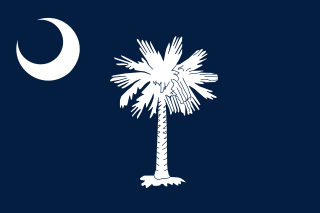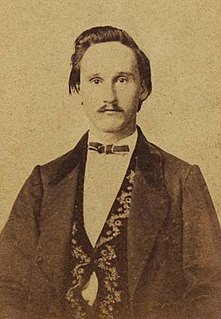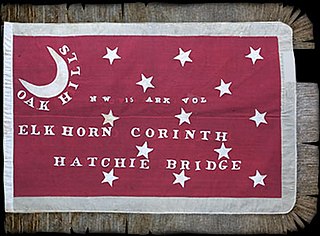Related Research Articles

The New Mexico campaign was a military operation of the Trans-Mississippi Theater of the American Civil War from February to April 1862 in which Confederate Brigadier General Henry Hopkins Sibley invaded the northern New Mexico Territory in an attempt to gain control of the Southwest, including the gold fields of Colorado and the ports of California. Historians regard this campaign as the most ambitious Confederate attempt to establish control of the American West and to open an additional theater in the war. It was an important campaign in the war's Trans-Mississippi Theater, and one of the major events in the history of the New Mexico Territory in the American Civil War.
Cobb's Legion was an American Civil War unit that was raised on the Confederate side from the State of Georgia by Thomas Reade Rootes Cobb during the summer of 1861. A "legion" consisted of a single integrated command, with individual components from the infantry, cavalry, and artillery. When it was originally raised, the Georgia Legion comprised seven infantry companies, four cavalry troops, and a single battery. The concept of a multiple-branch unit was fine in theory, but never was a practical application for Civil War armies and, early in the war, the individual elements were assigned to other organizations.

James Dearing was a Confederate States Army officer during the American Civil War who served in the artillery and cavalry. Dearing entered West Point in 1858 and resigned on April 22, 1861 when Virginia seceded from the Union. Dearing was mortally wounded at the Battle of High Bridge during the Appomattox Campaign of 1865, making him one of the last officers to die in the war. Despite serving as a commander of a cavalry brigade and using the grade of brigadier general after he was nominated to that grade by Confederate President Jefferson Davis, Dearing did not officially achieve the grade of brigadier general because the Confederate Senate did not approve his nomination. His actual permanent grade was colonel.

Hampton's Legion was an American Civil War military unit of the Confederate States of America, organized and partially financed by wealthy South Carolina planter Wade Hampton III. Initially composed of infantry, cavalry, and artillery battalions, elements of Hampton's Legion participated in virtually every major campaign in the Eastern Theater, from the first to the last battle.

During the American Civil War, Arkansas was a Confederate state, though it had initially voted to remain in the Union. Following the capture of Fort Sumter in April 1861, Abraham Lincoln called for troops from every Union state to put down the rebellion, and Arkansas and several other states seceded. For the rest of the civil war, Arkansas played a major role in controlling the Mississippi River, a major waterway.
The Pointe Coupee Artillery was a Confederate Louisiana artillery unit in the American Civil War made up primarily of men from the parishes of Pointe Coupee, East Baton Rouge, Livingston and other surrounding parishes as well as a large number of men from New Orleans.

The Choctaw in the American Civil War participated in two major arenas— the Trans-Mississippi and Western Theaters. The Trans-Mississippi had the Choctaw Nation. The Western had the Mississippi Choctaw. The Choctaw Nation had been mostly removed west prior to the War, but the Mississippi Choctaw had remained in the east. Both the Choctaw Nation and the Mississippi Choctaw would ultimately side with the Confederate States of America.
Hispanics and Latinos in the American Civil War fought on both the Union and Confederate sides of the conflict. Not all the Hispanics who fought in the American Civil War were "Hispanic-Americans", in other words citizens of the United States. Many of them were Spanish subjects or nationals from countries in the Caribbean, Central and South America. Some were born in a US Territory and therefore did not have the right to US Citizenship. It is estimated that approximately 3,500 Hispanics, mostly Mexican-Americans, Puerto Ricans and Cubans living in the United States joined the war: 2,500 for the Confederacy and 1,000 for the Union. This number increased to 10,000 by the end of the war.

The units of the Arkansas Militia in the Civil War to which the current Arkansas National Guard has a connection include the Arkansas State Militia, Home Guard, and State Troop regiments raised by the State of Arkansas. Like most of the United States, Arkansas had an organized militia system before the American Civil War. State law required military service of most male inhabitants of a certain age. Following the War with Mexico, the Arkansas militia experienced a decline, but as sectional frictions between the north and south began to build in the late 1850s the militia experienced a revival. By 1860 the state's militia consisted of 62 regiments divided into eight brigades, which comprised an eastern division and a western division. New regiments were added as the militia organization developed. Additionally, many counties and cities raised uniformed volunteer companies, which drilled more often and were better equipped than the un-uniformed militia. These volunteer companies were instrumental in the seizure of federal installations at Little Rock and Fort Smith, beginning in February 1861.
Italian Americans in the Civil War are the Italian people and people of Italian descent, living in the United States, who served and fought in the American Civil War mostly on the side of the Union. A contingent of soldiers from the former Kingdom of the Two Sicilies fought on the Confederate side, with most of these having been former prisoners of war who had fought against Giuseppe Garibaldi during his invasion of the Two Sicilies. Between 5,000 and 10,000 Italian Americans fought in the civil war.

The 10th Arkansas Infantry (1861–1865) was a Confederate Army infantry regiment during the American Civil War from the state of Arkansas. The unit is also known as A. R. Witt's Infantry, C. M. Cargile's Infantry, E. L. Vaughan's Infantry, Thomas D. Merrick's Infantry, S. S. Ford's Infantry, Obed Patty's Infantry, George A. Merrick's Infantry, Zebulon Venable's Infantry and Robert C. Bertrand's Infantry in contemporary accounts. After being captured at the Siege of Port Hudson, the unit reorganized as a mounted infantry unit, and was known as the 10th Arkansas Cavalry Regiment or Witt's Arkansas Cavalry.

The 15th (Northwest) Arkansas Infantry Regiment (1861–1865) was a Confederate Army infantry regiment during the American Civil War. The unit was originally formed as the 3rd Arkansas Infantry Battalion. After receiving the required 10 companies, the unit was redesignated as the 21st (McRae's) Arkansas Infantry Regiment. Upon recognition that there was already a 21st Arkansas, the unit was again redesignated as the 15th Arkansas Infantry Regiment. This was the third Arkansas unit to bear the designation "15th Arkansas". The others are the 15th (Josey's) Arkansas Infantry Regiment and the 15th (Gee/Johnson) Arkansas Infantry Regiment. The unit saw action both west and east of the Mississippi, before serving in the Vicksburg campaign. The regiment was surrendered at Vicksburg in July 1863. After being paroled and exchanged, the regiment was consolidated with other depleted Arkansas regiments to form the 1st (Trans-Mississippi) Arkansas Consolidated Infantry Regiment.

Miles' Legion was a unit of the Confederate Army during the American Civil War. It was commanded by Col. William R. Miles.
Preston Pond Jr. was a lawyer and politician from Louisiana, who served as a colonel in the Confederate States Army during the American Civil War.

Hilliard's Legion or Hilliard's Alabama Legion was a Confederate unit which fought in the American Civil War. Unlike most Civil War formations, it was a combined arms force, with infantry, cavalry and artillery components.
The 118th Field Artillery Regiment is a field artillery regiment of the Georgia Army National Guard. The regiment's 1st Battalion is the cannon battalion assigned to the 48th Infantry Brigade Combat Team. It is one of several National Guard units with colonial roots and campaign credit for the War of 1812.

The 21st Louisiana Infantry Regiment, also called the McCown Regiment, was an infantry regiment from Louisiana that served in the Confederate States Army during the American Civil War. Six of its companies formed the 5th Louisiana Infantry Battalion organized in September 1861, which fought in the Battle of Belmont as cannoneers. The battalion was brought up to regimental strength, becoming the 21st Louisiana, by the addition of four companies in February 1862. After service at Island Number Ten, Fort Pillow, and the Siege of Corinth, the regiment was disbanded due to its high desertion rate.
References
- 1 2 3 Field, Ron (2006). The Confederate Army 1861-65: Virginia & Arkansas, Volume 4. Osprey Publishing. p. 5. ISBN 1-84603-031-5 . Retrieved January 29, 2011.
- 1 2 "Washington Artillery Arsenals". washingtonartillery.com. Retrieved August 21, 2015.
- ↑ "New Orleans Mayors". storyvilledistrictnola.com. Retrieved August 21, 2015.
- 1 2 3 4 5 6 7 Mehrländer, Andrea (2011). The Germans of Charleston, Richmond and New Orleans During the Civil War Period, 1850-1870: A Study and Research Compendium. Walter de Gruyter. pp. 114–117. ISBN 9783110236880 . Retrieved August 22, 2015.
- ↑ "18th Louisiana: Letters Home" . Retrieved August 21, 2015.